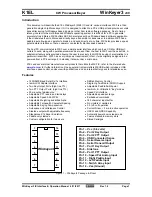Typically, a relatively simple interface pod is used to translate commands from a host
computer into commands for the custom serial interface to the single-wire background
debug system. Depending on the development tool vendor, this interface pod may use a
standard RS-232 serial port, a parallel printer port, or some other type of communications
such as a universal serial bus (USB) to communicate between the host PC and the pod.
The pod typically connects to the target system with ground, the BKGD pin, RESET, and
sometimes V
DD
. An open-drain connection to reset allows the host to force a target
system reset, which is useful to regain control of a lost target system or to control startup
of a target system before the on-chip nonvolatile memory has been programmed.
Sometimes V
DD
can be used to allow the pod to use power from the target system to
avoid the need for a separate power supply. However, if the pod is powered separately, it
can be connected to a running target system without forcing a target system reset or
otherwise disturbing the running application program.
NO CONNECT 3
2
4
6
NO CONNECT 5
BKGD 1
GND
V
DD
RESET
Figure 18-1. BDM tool connector
18.2.1 BKGD pin description
BKGD is the single-wire background debug interface pin. The primary function of this
pin is for bidirectional serial communication of active background mode commands and
data. During reset, this pin is used to select between starting in active background mode
or starting the user's application program. This pin is also used to request a timed sync
response pulse to allow a host development tool to determine the correct clock frequency
for background debug serial communications.
BDC serial communications use a custom serial protocol first introduced on the
M68HC12 Family of microcontrollers. This protocol assumes the host knows the
communication clock rate that is determined by the target BDC clock rate. All
communication is initiated and controlled by the host that drives a high-to-low edge to
signal the beginning of each bit time. Commands and data are sent most significant bit
first (MSB first). For a detailed description of the communications protocol, refer to
.
If a host is attempting to communicate with a target MCU that has an unknown BDC
clock rate, a SYNC command may be sent to the target MCU to request a timed sync
response signal from which the host can determine the correct communication speed.
Chapter 18 Development support
MC9S08PA4 Reference Manual, Rev. 5, 08/2017
NXP Semiconductors
353
Содержание MC9S08PA4
Страница 1: ...MC9S08PA4 Reference Manual Supports MC9S08PA4 Document Number MC9S08PA4RM Rev 5 08 2017 ...
Страница 2: ...MC9S08PA4 Reference Manual Rev 5 08 2017 2 NXP Semiconductors ...
Страница 22: ...MC9S08PA4 Reference Manual Rev 5 08 2017 22 NXP Semiconductors ...
Страница 28: ...System clock distribution MC9S08PA4 Reference Manual Rev 5 08 2017 28 NXP Semiconductors ...
Страница 150: ...Port data registers MC9S08PA4 Reference Manual Rev 5 08 2017 150 NXP Semiconductors ...
Страница 196: ...Human machine interfaces HMI MC9S08PA4 Reference Manual Rev 5 08 2017 196 NXP Semiconductors ...
Страница 224: ...Instruction Set Summary MC9S08PA4 Reference Manual Rev 5 08 2017 224 NXP Semiconductors ...
Страница 232: ...Functional Description MC9S08PA4 Reference Manual Rev 5 08 2017 232 NXP Semiconductors ...
Страница 258: ...FTM Interrupts MC9S08PA4 Reference Manual Rev 5 08 2017 258 NXP Semiconductors ...
Страница 268: ...Initialization application information MC9S08PA4 Reference Manual Rev 5 08 2017 268 NXP Semiconductors ...
Страница 294: ...Functional description MC9S08PA4 Reference Manual Rev 5 08 2017 294 NXP Semiconductors ...
Страница 370: ...Memory map and register description MC9S08PA4 Reference Manual Rev 5 08 2017 370 NXP Semiconductors ...
Страница 398: ...Resets MC9S08PA4 Reference Manual Rev 5 08 2017 398 NXP Semiconductors ...
Страница 400: ...MC9S08PA4 Reference Manual Rev 5 08 2017 400 NXP Semiconductors ...


















